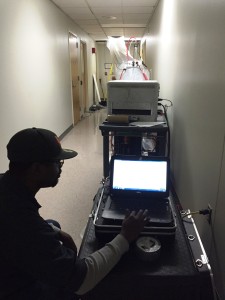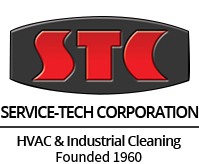By STC Leadership on Jan 28, 2015 1:26:58 PM
 A STC technician monitors the injection of a vinyl acetate polymer through a highly effective, computer-controlled process for sealing duct system leaks in a government crime lab facility.
A STC technician monitors the injection of a vinyl acetate polymer through a highly effective, computer-controlled process for sealing duct system leaks in a government crime lab facility.
According to the U.S. Department of Energy, a study by the Lawrence Berkeley National Laboratory found that the duct leakage rates of commercial buildings exceed the ASHRAE (American Society of Heating, Refrigerating and Air-Conditioning Engineers) recommended classes by an average of 20%. This rate of leakage results in increased energy consumption, thermal loss, equipment overload, code issues and air balancing problems.
Just ask the personnel working in the offices of an Ohio county coroner. Due to air balance and pressurization problems in the crime lab and autopsy rooms, odors were migrating throughout the building, particularly in the warmer months. Needless to say, the staff had no qualms about bringing this issue to the attention of the facilities management people.
Service-Tech Corporation was called to determine if air duct leakage could be a factor in the air quality of other areas in the building. Two dedicated exhaust fans serving the autopsy suites and cold storage area had recently been replaced in an effort to keep these areas under negative pressure, but the problem persisted. A visual inspection of representative sections of the supply and exhaust air conveyance systems determined that sealing the ductwork was necessary to restore the mechanical integrity of the duct systems and to facilitate proper air balance.
Service-Tech Corporation was contracted to first, measure the amount of air leakage, then seal the ductwork from the inside out utilizing the proven, patented Aeroseal Certified Duct Diagnostics and Sealing Technology. This was followed by the generation of a post-seal report and certificate showing the reduction in air leakage for each system. The supply zone had an initial leakage rate of 337.8 cfm (cubic feet per minute) and a post-seal leakage rate of 0.0 cfm which corresponds to a 100% reduction in duct leakage. The two exhaust systems had a combined initial leakage rate of 632.6 cfm and a post-seal leakage rate of 42.6 with a corresponding reduction in duct leakage of 94.7%.
Sealing ducts can be one of the most efficient ways to reduce energy costs, improve indoor air quality and enhance building pressurization. It also helps to ensure proper air balance, thereby reducing the risk of pollutants and contaminants from entering ducts and circulating throughout the building.
Health and safety issues associated with improper air pressure and balance should not be taken lightly. For example, hospital isolation rooms typically require constantly controlled air pressure (negative or positive) to prevent contagions from migrating into or out of the room. Also, gas appliances and mechanical equipment in homes and businesses can release harmful gases like carbon monoxide that are potentially drawn back into ventilation systems through leaky ductwork. Sealing any leaks will minimize this risk.
Sealing solutions:
Leaking ducts can be sealed in different ways. If the exterior of the ductwork is accessible, duct tape and/or mastic tape can be manually applied to joints and seams. Ducts can also be sealed from the inside with coatings comprised of a high solid content, although this only works on small leaks and cracks up to 1/8 of an inch. Even with properly sealed ductwork, thermal cycling can damage sealant adhesives, especially the rubber-based adhesive in duct tape, increasing leakage over time. Constant pressure cycling also may wear out duct seals, particularly with inadequately supported ductwork.
Service-Tech prefers to seal ductwork using the new technology developed by Aeroseal (used at the crime lab mentioned earlier). The process — which detects and seals leaks up to 5/8 of an inch — involves pressurizing the duct system by temporarily blocking inlet and outlet points and injecting a vinyl polymer in vapor form that stays suspended in the air until it detects a leak. The sealant particles are gradually deposited in the leaks by the exiting air-stream as it bends and accelerates through the leaks. As the process continues, the particles begin to accumulate in the leaking cracks and holes until they are eventually sealed. The injection process is monitored and controlled by a laptop computer that calculates the equivalent loss of cfm through leakage at the beginning of the sealing. It then monitors and displays the reduction and remaining leakage in real time. When the sealing is finished, a complete minute-by-minute record is provided.
This technology uses a safe vinyl polymer, has no lingering odors or off-gassing, and does not coat ductwork or require cleaning before sealing (unless more than 1/8th inch of debris). Another big advantage is that it lasts more than 10 years.
As a licensed service provider of Aeroseal, Service-Tech has used this process to seal ducts with as much as 40% leakage before sealing to the point of less than 10%, and in some cases as low as 0%, after sealing. It’s amazing technology and very efficient. Most people don’t believe what it can do until they see it work.
Whatever method you choose to seal the ductwork in your home or facility is optional. What’s not a good option is allowing them to continue to leak. Have a qualified contractor seal the ducts; you’ll be glad you did, and so will others.
Chris Aiple
Director of Operations/Sales/Southwest OH, Northern KY, Southern IN
800.298.8953
![]()
Minimize machine downtime and maintain a clean and safe environment for your employees with an HVAC system cleaning partner backed by a history built on hard work, integrity and a commitment to excellent service. Let’s talk about a cleaner, healthier environment.
